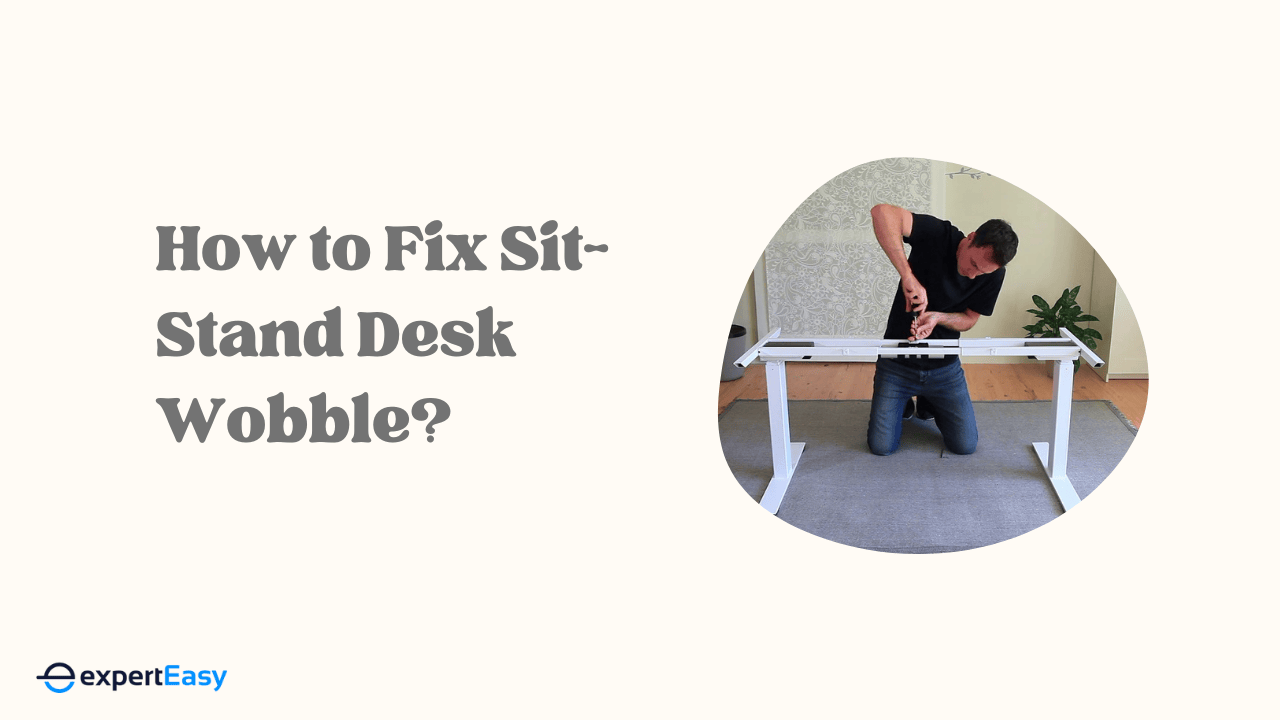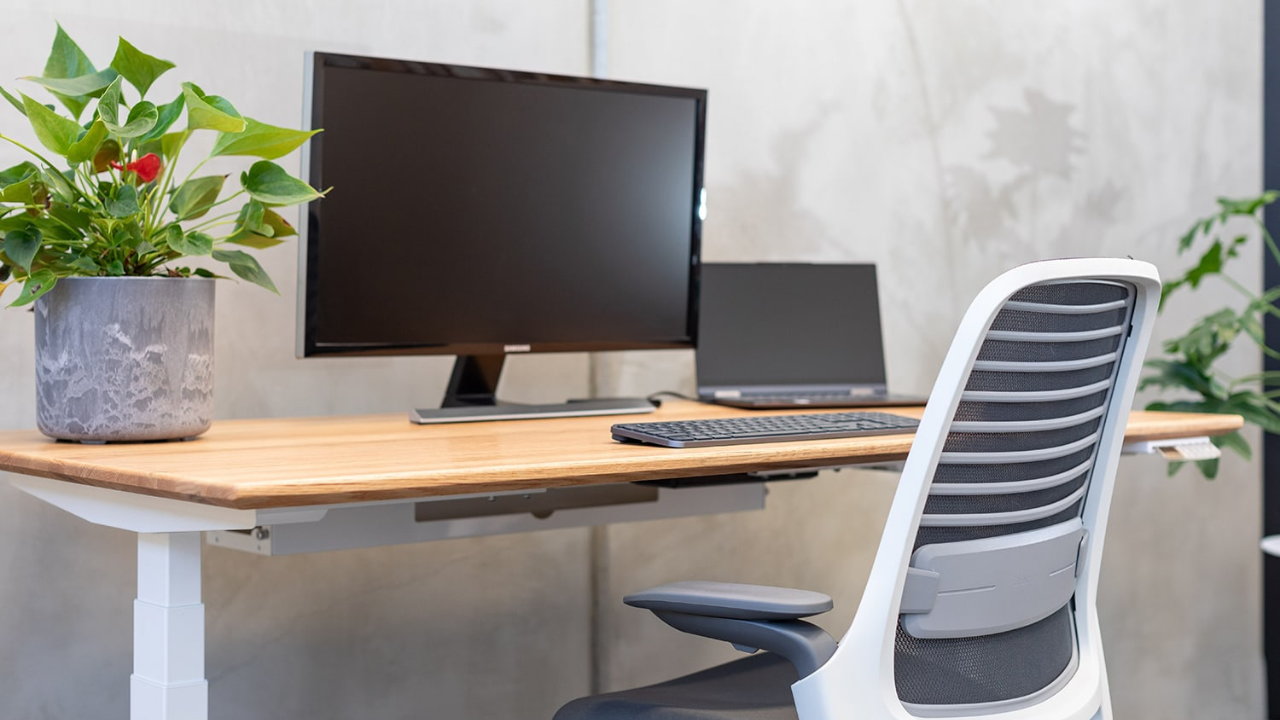A wobbling sit-stand desk disrupts your workflow and adversely affects your productivity. Most often, it’s caused by an uneven floor, loosened bolt or fastener, poor desk assembly, and uneven weight distribution.
Other times, there are more complicated causes, like poor build quality and materials, that require the manufacturer's attention. In this post, I’ll share how these factors contribute to your standing desk wobbling and provide you with practical solutions to stabilise it.
How to Fix Sit-Stand Desk Wobble?
A stable desk is crucial for a comfortable and productive workspace. But to find a solution to your wobbling desk issue, it’s essential to find the root of your problem. Here are some causes and solutions:
#1 - Uneven floor

An uneven floor is often the most common reason for a wobbly desk. To determine this, gently push down on each desk corner, one at a time. If any specific leg lifts off the ground, the floor beneath that leg is uneven.
Likewise, you can place a small ball on the desk surface and observe if the ball rolls in any particular direction. This is effective if you look around the floor and find no visible dips, slopes, or irregularities.
Uneven floor solutions
Once you’ve confirmed that an uneven floor is causing your sit-stand desk to wobble, choose which solution below best applies:
- If your desk has adjustable feet, adjust them appropriately to balance the desk.
- To level the desk, place shims under the shorter legs. These can be made from wood, plastic, or rubber and cut to size for a perfect fit.
- Consider placing a thick mat or rug under the desk to rectify minor floor irregularities.
#2 - Loosened bolts
Over time, the bolts, screws, and fasteners that hold your standing desk together become loose due to regular use, moving the desk, or vibrations. You can confirm this by applying pressure to the joints and connection points and looking for noticeable movement or creaking noise.
Steps to fix loose bolts
Here's how to fix loose bolts:
- Get an Allen wrench or a screwdriver.
- Go through each bolt and tighten them securely.
- If you have missing bolts, replace them with the correct size and type.
- Consider adding lock washers or applying a thread-locking compound to prevent bolts from loosening again.
Loose bolts are one of the easiest to fix. I recommend doing regular checks to prevent future wobbling and keep your desk functioning smoothly.
#3 - Low-quality build

Some sit-stand desks are made from lighter materials or have a less robust design, making them inherently flexible and prone to wobbling. There’s nothing you can do about that than invest in a quality desk. High-end standing desks made from sturdy materials are less likely to wobble.
Consider reinforcement if purchasing a new desk is not an option. Adding support brackets or crossbars can help increase stability. However, I don’t recommend this approach as it can impact the desk’s adjustment.
#4 - Overloaded weight
All sit-stand desks have static and dynamic weight limits; exceeding them causes instability. The static limit is the maximum weight the desk supports when stationary, while the dynamic limit is the maximum weight the desk handles when adjusted between sitting and standing positions.
To check if you’ve exceeded either weight capacity, gently push the desk without adjusting the height. If the desk remains stable when stationary but wobbles during height adjustment, you've most likely exceeded the dynamic weight limit.
To prevent this, check the desk's user manual to find the maximum weight limits (static and dynamic), compare these limits with the actual weight of the items on your desk, and adjust accordingly. If the wobbling persists despite being within limits, other factors could be at play.
#5 - Poor assembling

Incorrectly assembling your sit-stand desk can lead to an unstable desk. Missing screws, improper alignment, or wrong setups all contribute to wobbling. This often happens during your first assembly process. Sometimes, as I’ve once been a victim, it’s down to an incorrect assembly manual.
To verify, check that all fasteners, i.e., screws, bolts, etc., are securely tightened. Loose fasteners are a common cause of wobbling, as I’ve explained above. Also, look out for missing parts and ensure that all parts listed in the assembly instructions are present and correctly installed.
Poor assembling solution
If your standing desk is wobbling from poor assembling, do the following:
- Return to the assembly instructions and ensure that every step is followed correctly and all components are properly aligned.
- If you suspect the desk is improperly assembled, disassemble and reassemble it, paying close attention to each step.
- If you’re unsure about assembling the desk, consider seeking help from a professional or manufacturer.
Where applicable, always choose assembly by the manufacturer—most desk brands offer this service for an additional cost. Plus, it eliminates the risk of voiding your warranty due to incorrect setup.
#6 - Worn Components
Over time, a desk's build materials and components can wear out, including the legs, joints, and any moving parts. This wear and tear can lead to instability and wobbling. Here’s how to solve or prevent this:
- Regularly inspect your desk for signs of wear and tear. Look for cracks, worn-out joints, or other damage.
- Replace worn components as soon as possible. Many manufacturers offer replacement parts, or you can find generic parts that fit your desk.
- Implement preventive maintenance practices such as lubricating moving parts and tightening screws and bolts regularly to extend the lifespan of your desk components.
Most standing desks have a lifespan of 5 to 20 years, depending on their build and type. Electric desks can handle over a decade of continuous use, while manual options can do two if adequately maintained.

Additional Tips for a Stable Desk
For optimal stability and performance of your standing desk, consider implementing these additional tips:
- Add stability brackets: If the desk allows, consider installing additional stability brackets or supports to reinforce its structure.
- Use desk pads: Place anti-slip pads under the legs to prevent sliding and add extra stability.
- Minimise height adjustments: If your sit-stand desk wobbles when raised, minimise frequent adjustments and find a comfortable height that requires fewer changes.
- Position near walls: For additional support, position your standing desk close to a wall or use wall anchors if necessary.
How to Choose a Standing Desk?

A quality sit-stand desk saves you from a lot of wobbling issues. Here are three simple steps to choose a suitable desk:
Step #1 - Needs and budget
First things first, consider how often you plan to use the standing desk. Will it be for occasional use or daily work? Would it fit comfortably where you intend to use it? I often recommend measuring the available space in your office or home to ensure the desk fits comfortably.
Once done, determine your ideal desk type, features, and accessories. Then, set a budget that aligns with your financial capacity. It's important to balance quality and cost. Investing in a durable, high-quality desk saves you money as you avoid frequent repairs and replacements.
Step #2 - Desk types and mechanisms
It’s time to take your spec sheet to the market. Check your budget and required features against the various desk options.
Here are a few things to consider.
- Do you want a simple manual desk or the convenience of electric height adjustment? Evaluate the pros and cons of each mechanism in relation to your workflow and ergonomic requirements.
- Weight capacity is crucial, especially if your work setup involves heavy equipment or multiple monitors. Be sure to match your desk's weight capacity with the demands for stability and longevity.
- Choose durable materials and sturdy construction to ensure your desk withstands daily wear and tear.
Comparing your spec sheet with the diverse sit-stand desk options in the Australian market helps you find the best option that fits the intersection of your needs, budget, and expectations.
Step #3 - Ergonomics and comfort
A suitable standing desk must ensure ergonomic comfort. Start by checking if the desk has a sufficient height range to accommodate you. Remember, your elbows should be at a 90-degree angle when typing, and the top of your monitor should be at or slightly below eye level.
Likewise, ensure the desk surface is large enough to hold your work essentials. If possible, visit a showroom or store to test the available standing desks. This practice allows you to physically experience the desk's stability, ease of adjustment, and overall build quality.

Bottom Line
That's all I have for you. Remember to always start by identifying the root cause—whether it's uneven flooring, loose screws, or improper assembly—before applying the appropriate and effective solution.
To get the most out of your standing desk, regularly maintain and address any potential wobbling as soon as it starts. This way, you can ensure a sturdier, more comfortable workspace. A stable desk isn't just convenient; it enhances productivity and overall health.








